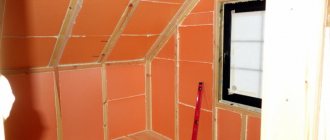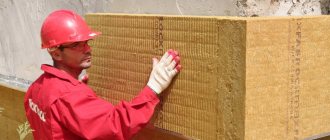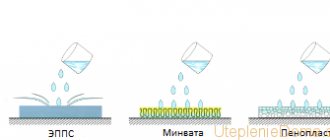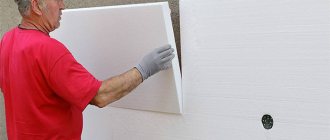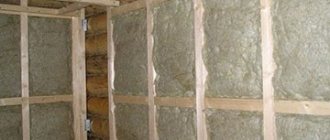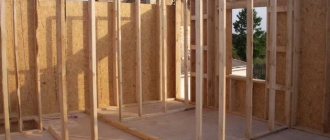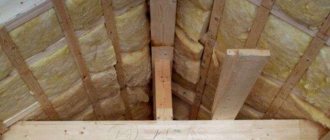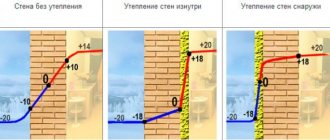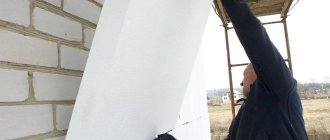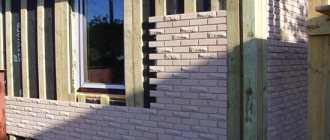To build a comfortable, warm home, it is not enough just to install heating and seal the seams .
With thin walls that do not retain heat well, heating costs will be incredibly high, and the heat in the house will not be retained.
To ensure that warm air does not escape from the room, and that the walls perform not only the function of protection from external influences, but also the function of thermal insulation, it is necessary to insulate them.
The following materials are suitable for insulation:
- mineral wool;
- Styrofoam;
- extruded polystyrene foam;
- penoplex;
- penofol;
- penoizol;
- polyurethane foam.
Insulation of walls inside and outside the house - differences
Wall insulation is carried out both inside and outside .
If it is necessary to insulate walls, then, as a rule, one insulation option is chosen: either from the inside of the load-bearing wall or from the outside.
It is also possible to insulate a wall on both sides, but this is not always necessary : insulation options are chosen based on climatic conditions, construction features, and individual preferences.
Indoor insulation is installed on the inside of the building.
The disadvantages of this option are the following:
- the free space of the room decreases;
- the likelihood of dew point formation inside the wall or between the insulation and the wall.
Internal insulation of the walls of a house is good because:
- weather conditions will not affect the work schedule;
- If the building has cladding, it is possible to preserve it unchanged.
IMPORTANT!
When installing internal insulation, it is necessary to install a reliable vapor barrier inside the building.
Insulation of external walls is carried out from the outside of the building. With this type of thermal insulation, the usable area of the structure is preserved; there is no need to install a vapor barrier layer . However, if the cladding of the building has already been completed, it must be dismantled.
External insulation
How to insulate a wall inside an apartment: we insulate the inner wall with our own hands
Insulating an apartment from the inside most often becomes necessary in houses with panel walls, since they are not thick enough, quickly cool down, the heating system cannot fully cope with its tasks, and the temperature in the rooms drops. How to insulate a wall inside an apartment, and what methods and materials to use - this question faces the majority of homeowners in concrete high-rise buildings. The outer walls in such houses become cold especially quickly, and often due to temperature changes they begin to become damp and covered with mold.
How to insulate a wall inside an apartment
Expert opinion: Afanasyev E.V.
Chief editor of the Stroyday.ru project. Engineer.
Sometimes, when possible, the walls are thermally insulated from the outside, as this is a more effective way to retain heat. However, this option is very expensive due to the complexity of its implementation, and it is impossible to carry out such measures independently, without the use of special equipment, if the apartment is located above the first or second floor. Therefore, a decision is made to insulate the walls from the inside, to the detriment of the total usable area. But, be that as it may, a warm apartment of a slightly smaller area is better than large, cold rooms. Internal work can easily be done with your own hands, without the involvement of specialists. The main thing is to choose the right material and have the right tools.
If the apartment has autonomous heating equipment, then insulating the walls will help save energy resources, which are very expensive today.
Disadvantages of internal insulation
Compared to external thermal insulation of walls, internal insulation of an apartment has its rather significant disadvantages:
- An insulated wall does not accumulate or retain heat, and heat losses range from 8 to 15%.
With internal insulation, the “dew point” may be inside the insulation, which leads to its dampening
- The “dew point” for internal thermal insulation is located between the insulation and the wall, sometimes inside the insulation layer. This leads to the formation of condensation and the appearance of mold colonies.
- A wall that is improperly insulated from the inside will freeze all the time, and this inevitably causes, over time, irreversible destructive processes in the thickness of the material.
Proper insulation
To prevent condensation from forming under the thermal insulation layer due to temperature changes in winter, and also, as a consequence, to prevent mold spots from appearing on the walls, you must carefully follow all technological recommendations for insulating concrete walls from inside the apartment.
Vapor barrier for internal insulation is of particular importance
An important element in the structure of the thermal insulation “pie” is high-quality vapor barrier. It should protect the insulation from moisture penetration, which will allow the entire structure to effectively perform its functions for a long time.
What kind of work needs to be done to achieve the goal?
- It is necessary to purchase a high-quality vapor barrier film and waterproof tape to seal the seams at the connection of its sheets.
- For the insulating layer, you need to choose a material that has low vapor permeability. It is desirable that this indicator be lower than the vapor permeability of the wall material. In this case, moisture evaporation will occur towards the street, and not inside the apartment.
- When gluing the insulation, its surface is completely coated with glue using a spatula-comb, and it is pressed very tightly against the surface of the wall, so that there are not even small cavities left between them.
- To avoid the occurrence of excessively high relative humidity indoors, they must be equipped with additional natural or forced ventilation. For example, for this, valves are installed on window frames through which air will flow into the room.
Ventilation valves on windows
- Next, you need to accurately calculate the required thickness of the insulation. It will depend on the average daily temperature in a given region in winter. The thickness of the thermal insulation material should not be less than the parameters obtained during the calculations, otherwise the steam-heat balance will be disrupted.
- Before installing the insulation system, the walls must be treated with special primers. They will “cure” the wall, prevent mold colonies from forming on it, and also increase adhesion when gluing thermal insulation.
- Installation of insulation can begin only after the wall has completely dried.
- The formation of “cold bridges”, which can negate the entire insulation process, should not be allowed. The risk of their occurrence is especially high at the junctions of walls and ceilings.
What insulation materials and how are they used?
For the process of insulating a wall from the inside, several types of insulation are used. Which one to choose is up to the homeowner to decide after he becomes more familiar with their characteristics and installation methods.
Mineral wool
Mineral wool is a traditional material for insulating interior work, but for concrete exterior walls you need to choose a type of thermal insulator that has a very high density - this creates vapor tightness, which is necessary in this case. The property of mineral wool to allow air to pass through, i.e. “breathing” in this situation is rather harmful, since condensation will form on the wall when the temperature changes. To avoid this, it is necessary to choose mineral wool with a high density, comparable to polystyrene foam.
Mineral wool should be used for internal wall insulation with extreme caution.
In addition, high-quality installation of vapor barrier is necessary. If all these conditions are not met, the work will be done in vain, since after the appearance of fungus and the smell of dampness in the premises, the structure will have to be dismantled. Therefore, to insulate external walls that are not insulated from the street, it is better to abandon the use of mineral wool, or use only dense types of it with the creation of the necessary air gap for ventilation. More details about this in the proposed video:
Video: insulating a wall inside using mineral wool
Expanded polystyrene
Polystyrene foam, polystyrene foam or penoplex are more suitable for insulating external walls from inside the apartment. These materials have all the necessary properties, the main one of which is low thermal conductivity. In addition to this quality, polystyrene foam has other important characteristics that predetermine the possibility of its use specifically for internal thermal insulation work:
Extruded polystyrene foam is an excellent insulation material, but it “eats up” a lot of usable space
- The mass of the material is small, and this makes installation easier. In addition, the hard and smooth surface allows it to be easily mounted on the wall.
- Expanded polystyrene is easy to process - if necessary, it can be cut using a construction knife.
- The material is able to withstand tearing forces and strong compression, which often occur in walls, for example, during temperature changes or shrinkage of the structure.
Since ordinary or extruded polystyrene foam practically does not absorb moisture, it will not allow it to reach the “dew point”, so when using this material, you do not need to use a vapor barrier. At the junctions of walls and floor slabs, cold bridges can be insulated using polyurethane foam. You can also attach the slabs to the wall surface with foam - as it expands, it will fill all the gaps between the insulation slabs and the wall, making the surface airtight. Special locking grooves and spikes found on extruded polystyrene foam boards will help make the surface seamless.
The locking tongue-and-groove part greatly simplifies the installation of insulation
Having installed a number of slabs, they are attached to the wall using special “fungi” fasteners. To do this, the mounted panels are drilled through, making a hole in the wall, and then the fasteners are hammered into it.
Fastening polystyrene foam boards to the wall
It should be noted that foam does not sufficiently muffle noise and this is one of its disadvantages. In addition, any type of polystyrene foam is flammable, to one degree or another, and when ignited, it releases substances hazardous to human health.
Expanded polystyrene boards can be plastered on top or sealed with plasterboard
After installing the slabs and “sealing” all the cracks and seams, the thermal insulation layer can be plastered or covered with sheets of plasterboard.
Video: insulating an internal wall with polystyrene foam panels
Polyurethane foam
Polyurethane foam is a form of foaming polymer that is sprayed using special equipment onto a prepared wall. At the everyday level, almost everyone has encountered it if they used polyurethane foam.
A lathing made of wooden beams is pre-fixed to the insulated wall, which will serve as support guides for the sprayed material, as well as the basis for attaching decorative finishing or sheathing with plasterboard sheets.
Polyurethane foam spraying process
Polyurethane foam is good because it penetrates into all cracks and irregularities, creating a seamless, sealed surface that fits tightly, without any “pockets” or voids, to the load-bearing wall, leaving no cavities for condensation to accumulate.
This material is moisture resistant and has a very low thermal conductivity. When deciding to use polyurethane foam, you can safely abandon hydro- and vapor barrier.
Installation of polyurethane foam is carried out quite quickly, but without special equipment it will not be possible to do it yourself, so you will have to invite specialists.
Insulation with polyurethane foam is very effective, but it can only be carried out by specialists
In addition to the above positive qualities of this material, the following can be mentioned:
- After spraying, polyurethane foam quickly takes on three-dimensional shapes and hardens. Thus, having installed such a thermal insulation layer, the very next day you can safely begin installing drywall.
- The insulation perfectly seals “cold bridges” at the joints of planes.
- Polyurethane foam has good adhesive qualities to any smooth or uneven surfaces and perfectly isolates the dew point from moisture penetrating into it from the inside.
- The material is convenient for insulating rooms with non-standard shapes, for example, if the transition from the wall to the ceiling has an arch structure or the walls are made in a curved configuration.
- Such a coating can have any type of exterior finish - plasterboard or plaster, depending on the choice of the owners of insulated housing.
Video: insulating walls from the inside by spraying polyurethane foam
Cork
Another insulation material that can be installed independently is cork.
Cork is an excellent natural material for thermal insulation.
Such a thermal insulator is made in the form of slabs or rolls from the bark of a special type of oak - balsa wood. Therefore, it is an environmentally friendly, safe insulation material, which is very important for interior decoration.
Using high-quality material, you can solve three problems at once - noise and sound insulation, as well as decorative wall decoration.
An important condition for installing cork covering is the evenness of the wall, so before you start gluing it, you need to carefully prepare the surface. This process is carried out as follows:
- The old coating is completely removed from the wall.
- Then the entire surface is treated with an antiseptic primer, which will protect the wall from damage by fungus or mold.
Leveling walls with plaster
- The next step is to level the surface with plaster.
- You can also decorate the walls with drywall, but in this case, the sheet must be completely coated with waterproof glue or foam, so that there are no voids left underneath. The drywall is pressed firmly against the wall and is additionally secured with anchors or plastic “fungi”.
- Cork material can be glued to a dry wall. To do this, use a special glue designed for such purposes.
Special adhesive for working with cork
The positive qualities of the material, in addition to its environmental friendliness, low thermal conductivity and good noise absorption, include:
- Easy installation of cork wall coverings, provided you are careful in your work.
- Aesthetically attractive respectable appearance.
- The surface of the material is always warm and pleasant to the touch.
- A variety of release forms, textured patterns and shades.
Cork is not only an excellent thermal insulator. It will give the room a special decorative touch.
- Cork insulation is not very thick, so it does not make the area of the room smaller - this quality sets it apart from other thermal insulation materials.
Penofol
Penofol at its core is a roll of foamed polyethylene with a thickness of 2 to 10 mm, on one side of which a foil coating is applied, which helps to reflect heat into the room.
Penofol - foamed polyethylene with foil coating
- Before installation, the surface is prepared in the same way as for cork.
- Penofol can be secured to smooth walls using double-sided construction tape. Under any circumstances, the material is placed with the foil side facing the room. This creates a kind of thermos for effective heat retention.
- Penofol strips are laid end to end. They are glued together with special tape, which also has a foil reflective surface, since the entire coating must be airtight.
The sheathing is installed on top of penofol, laid with the foil side inside the room
- A sheathing of slats, bars or galvanized metal profiles is installed on top of the penofol fixed to the wall. This frame will become the basis for installing lining or covering the wall with plasterboard sheets. The plasterboard surface can subsequently be covered with plaster, wallpapered, or thoroughly puttied and sanded, and then painted.
- It is very important when installing drywall or lining at the top and bottom of the structure to leave a gap that will serve as a ventilation hole for air circulation to prevent moisture from accumulating.
Cladding an insulated wall with clapboard
Despite its small thickness, penofol is an excellent heat and sound insulator. It is used as a separate insulation, but it can also be used in combination with other materials. It attracts with its simplicity and speed of installation on walls, floors or ceilings, as well as its long service life.
Video: insulation of internal walls with foil material
Prices for thermal insulation materials
Thermal insulation materials
When choosing a material for insulating a living space from the inside, you must first examine all wall surfaces on which thermal insulation will be installed. If the wall is dry and there are no mold stains on it, then you can begin preparing the surface and purchasing insulating material. Carrying out such work on an unprepared basis is strictly prohibited. Not only will such insulation not give the desired effect, it can thoroughly spoil the apartment atmosphere, making it damp and unhealthy, since spores of many types of mold or mildew are extremely dangerous to people’s health, especially for those suffering from chronic respiratory diseases or a predisposition to allergic reactions.
In general, any of the methods presented in the publication for insulating an apartment from the inside will not require any complex additional equipment, and this technological process can be carried out independently.
Pie wall elements
Before insulating the walls of the house and attic, it is necessary to correctly lay the layers of the cake. Pie walls are sequentially laid layers of materials that serve to ensure a comfortable microclimate in the house.
The elements of the wall pie of a wooden house are:
- wooden frame made of timber . Most often made of beams 15x15 cm;
- horizontal wooden lathing , sometimes a metal profile is used;
- insulation made of mineral wool or expanded polystyrene;
- The membrane is multifunctional , performing the function of protection from winds and at the same time acting as a vapor barrier. It is a dense polyethylene film;
- vertical lathing;
- finishing material;
- vapor barrier film;
- internal cladding (plasterboard, lining).
wall pie
For all wooden wall elements, it is necessary to use high-quality wood , which must be dried naturally. In addition, materials should be chosen of high quality and durable so that the walls perform their functions for many years.
Insulating a house from the inside with mineral wool
Mineral wool is not an optimal thermal insulation material for internal insulation. There is only one reason for this - cotton wool allows steam to pass through perfectly. Because of this, described at the beginning of the article, the dew point shifts from the inner surface of the wall into the insulation itself. Condensation can accumulate in it, thermal performance deteriorate, and mold and mildew can form. However, it is possible to use mineral wool for internal insulation if all technological nuances are observed.
Choosing mineral wool for internal insulation
Mineral wool should be selected based on criteria such as thickness and environmental friendliness. It is possible to use rolled wool, which is cut to the required length directly during installation. Also, such products are produced in slabs. For internal insulation, 50 mm is the optimal thickness at which good insulation is achieved without significant loss of the usable volume of the room.
Example of suitable types of mineral wool:
- Ecoroll Plate 40. It has a relatively small thickness of 50 mm and does not contain phenol resins. Recommended by the manufacturer for internal insulation, including walls.
- TeploKNAUF For COTTAGE Thermo Plate is a modern insulation material from a well-known manufacturer, the features of which are: low thermal conductivity (0.37 W/m*K) and excellent water-repellent properties due to impregnation of the fibers with a special composition. In addition, this board has a special fiber arrangement structure, due to which sound absorption significantly increases. Thus, this insulating material is recommended for insulating the inside of walls, floors, and attics in houses located in noisy areas.
Basalt wool for internal insulation
Separately, attention should be paid to a type of mineral insulation such as basalt wool. The peculiarity of this heat insulator is not only its excellent thermal insulation properties and environmental friendliness, but also its high fire safety. Basalt fiber is obtained from natural stone. Accordingly, such a material has excellent resistance to open flames.
The fire resistance of basalt wool is an important nuance that must be taken into account when insulating the walls of wooden houses, country houses, and baths. In this case, we especially recommend choosing certified products.
These could be slabs:
- Rockwool Light Butts SCANDIC. Products that are designed specifically for insulating residential buildings, apartments and cottages. It is characterized by compliance with environmental standards (has low resin emissions, safe in residential areas). Flexi technology ensures simple installation with filling of gaps in the frame due to the spring properties of the insulation. The material is biostable - bacteria and mold do not form in it, and it is not a good habitat for insects or rodents.
- Rocklight insulation. Manufacturer TechnoNIKOL recommends using this insulation for internal thermal insulation from inside walls, floors, and attics. The material has low thermal conductivity (0.39-0.41 W/m*K). It is non-flammable, bioresistant, and due to special impregnations, it repels water well without accumulating it inside the structure. At the same time, the compressibility of the slab is 30%, which makes it possible to simplify the process of laying it between the joists and efficiently seal all the cracks and gaps.
Installation of mineral wool indoors
- A vapor barrier film must be installed around the perimeter of the wall.
- A frame made of wooden blocks is mounted on top of the vapor barrier. It is not recommended to use metal profiles. Metal perfectly transmits heat and will become an artificial bridge of cold
- !!! The metal frame should be used when arranging thermal insulation from the inside of objects with increased fire safety requirements together with basalt wool. These include wooden buildings: baths, saunas, etc. !!!
- The joints between the frame and the vapor barrier are taped with tape, since when fastened to the vapor barrier, a hole from the dowel is formed.
- Cotton wool is installed in the frame and carefully compacted to avoid the formation of any cracks.
- A second layer of vapor barrier is installed on top of the frame. This creates a double vapor barrier between the insulated wall and the room.
- The fastening points and joints of the vapor barrier are taped with aluminum tape.
- The frame is covered with preferred slabs - gypsum plasterboard, chipboard, etc.
If the technology is followed and only if a vapor barrier is installed in the insulation, a good result of internal thermal insulation can be achieved. On our own behalf, we would only like to add that insulating a house or apartment from the inside is, rather, an extreme and necessary measure. It is recommended to use it only if it is impossible to install thermal insulation from the outside. If such an opportunity exists, then we definitely recommend considering its implementation as a priority. We hope that the prepared publication will allow us to avoid mistakes and carry out internal insulation as efficiently as possible.
Types of insulation - which is better?
For proper internal insulation of a wooden house, insulation materials are used that, while maintaining thermal insulation properties, do not cause an unpleasant odor over time, are fireproof and environmentally friendly.
The most common options for internal insulation are:
- mineral basalt wool . It is the most popular material for wall insulation. The features of this material are: good thermal insulation properties, high level of sound insulation, fire resistance, strength, high hygroscopicity, due to which it is necessary to install piping from vapor barrier films;
- foam boards . Because the material can release styrene, extruded polystyrene foam is used, which requires a containment system. The material has good thermal insulation, has soundproofing properties, however, it is quite fragile;
- glass wool It has greater thermal conductivity than mineral wool, but the price of the material is significantly lower than basalt slabs. The material crumbles a lot, so it should be laid in protective equipment: crumbs of material are harmful to health. In addition, it is necessary to install enclosing structures;
- isoplat . Insulation, which consists of compressed flax fibers and wood board. An ideal thermal insulation material from the point of view of environmental friendliness, and also durable enough that it does not require the installation of fencing systems;
- polyurethane foam , which is installed by spraying it onto the surface, is installed using special equipment. Modern and quite expensive material.
Comparative characteristics of thermal insulation
The type of insulation should be chosen based on the characteristics of the building, climatic conditions, and the purpose of the building.
Thermal insulation wallpaper
Wallpaper with thermal insulation properties is an excellent solution that will not only insulate walls from the inside, but also hide small defects on the surface.
This type of wallpaper is made from polystyrene foam and is produced in rolls, the length of which reaches 10 meters, and the width ranges from 0.5 to 1 meter. Thanks to its insignificant thickness - 3.6 and 10 millimeters - thermal insulating wallpaper practically does not reduce the area of the room .
They have many advantages:
- pronounced thermal insulation properties (6 mm of such wallpaper is equivalent to 12 cm of a brick wall);
- providing reliable protection from extraneous noise;
- excellent moisture-resistant properties that prevent the formation of mold and fungi.
Wallpaper with thermal insulation properties is glued end-to-end using special glue onto a pre-made substrate.
The backing is applied to the cleaned walls after filling existing potholes and cracks with plaster. You can glue it with a special glue designed for heavy wallpaper or regular PVA. It is necessary to coat both the substrate itself and the wall with adhesive.
The backing for warm wallpaper to insulate the walls should be glued end-to-end. After this, you can start gluing the wallpaper in such a way that its sheets overlap the joints of the backing.
Insulation under wallpaper
Seal cracks in walls and insulate
In wooden beams dried using the appropriate technology, cracks form that need to be sealed.
Means for sealing cracks are:
- sealants and other synthetic products : resins, mastics, mounting foams. Synthetic sealants should not have an acrylic substance. Silicone seals must have a high level of frost resistance. The mixtures are placed deeply into the gap, and after drying the area is leveled. Polyurethane foam is used in places where facing work will subsequently be carried out;
- wood shavings mixed with wood glue . Used at any stage of finishing, as well as during additional inspection. The prepared mixture is poured into the previously cleaned crack of dust, then, after complete drying, the area is processed by grinding. The method is advisable to use for small cracks;
- decorative mixtures for sealing;
- fibrous materials - caulk (moss, wool, tow). Pre-cleaned cracks, impregnated with antiseptics and solutions that prevent the formation of mold, mildew, and dampness, are clogged with caulk.
NOTE!
Insulation at the joints of timber is done with sealants, mixtures or adhesive shavings . If the wall is made of logs, then the joints should be sealed only with fibrous materials.
Wood requires constant care and timely sealing of cracks that may appear over time. Regular inspection of the wood will help prevent gaps from growing, which can reduce the insulation properties of the walls.
Sealing tow
Sealing with sealant
Functions of sealing materials
Materials for sealing interpanel seams, junctions of window blocks, balconies, loggias with openings perform several functions and help maintain the required temperature and humidity conditions in the building.
Key tasks:
- Additional thermal insulation
. Insulation of interpanel seams increases the energy efficiency of the building, reduces heating costs, and eliminates drafts. - Waterproofing
. Hermetic sealing of joints prevents the formation of condensation, the appearance of fungus and mold on constantly wet areas of the wall on the room side.
Proper completion requires complex work. To solve problems of thermal and waterproofing, insulation is used - a special sealing gasket and curing mastic, which plays the role of a sealant.
Preparing the sheathing and installing it
For the sheathing of walls inside a wooden dacha, wooden materials are used. Metal lathing is installed when the wall is covered with moisture-resistant plasterboard.
The installation of sheathing includes a number of preparatory works in the following order:
- apply markings for installation of the sheathing. The width of the sheathing is selected based on the width of the insulation minus 2-5 millimeters . The insulation should stand up against the sheathing;
- preparation of corner posts . Necessary for creating an even wall angle. The height of the beam 50x100 mm should be equal to the height of the room. The smaller beam 50x50 mm is fastened with self-tapping screws to the edge of the larger beam, forming a right angle;
- making corner posts for all corners of the room;
- preparation of vertical boards for sheathing: boards are cut according to the height of the room in quantities corresponding to the pitch, 2 - 5 cm less than the insulation board.
Installation of the sheathing begins from the corners : using self-tapping screws, the corner posts are installed in their places, their vertical position is checked with a level. Next, from the corners to the center, the remaining sheathing boards are attached along the entire perimeter.
The next step is to install strips around the wall openings.
CAREFULLY!
All wooden elements of the sheathing must be treated with solutions against mold, mildew, and moisture.
After installing the lathing, a layer of heat-insulating material is laid.
Installation of sheathing
DIY insulation instructions
Due to the variety of thermal insulation materials, you can choose any of those on the market to insulate your room.
When purchasing, consider not only your financial capabilities, but also the requirements for the quality of the purchased material. It would be a good idea to ask the seller about the accompanying documents and the insulation quality certificate
Let us consider in detail the most popular options for internal thermal insulation of a room.
Method #1 - mineral or glass wool
To lay the material, you will need to make a frame from profiles and prepare sheets of drywall in advance for the purpose of subsequently closing the structure.
It is better to buy moisture- and fire-resistant plasterboard sheets - they will additionally protect the insulated wall from the penetration of dampness from the outside.
Step-by-step instructions for laying thermal insulation material:
- Install the profile along the entire perimeter of the wall, along the ceiling, walls, floor, and also make partitions between them in increments of 30-40 cm.
- Place mineral wool or glass wool in the prepared cells, leaving no empty spaces.
- Cover the structure with thermal insulation tightly with a vapor barrier film, make an overlap of 20-30 cm on the floor, ceiling, and adjacent wall.
- Seal the vapor barrier material to the floor and wall using double-sided tape.
- Cut the sheets of drywall with a construction knife into pieces of the required sizes.
- Install them using a screwdriver.
- Remove excess vapor barrier with a knife.
- Treat joints, cracks and holes with self-tapping screws with finishing or acrylic putty.
- After drying, level the surface with putty.
- Wait until it dries completely, then sand the wall with a fine mesh.
After completing the entire procedure, prime the surface and after a few hours it will be ready for finishing with decorating materials.
To perform the work, use a material with a high energy saving rate and a thermal conductivity of about 0.030 W/(m*°C). The properties of mineral wool are indicated on the outer packaging
This mineral wool has improved insulating properties compared to other similar materials. It can also be used to soundproof the ceiling.
Method #2 - PSB-S foam
A universal and most popular type of insulation, which is widely used in construction due to its low cost and decent heat saving performance. Choose high-density material with a width of 35-50 mm or more.
Polystyrene foam can be laid in several ways: in a pre-prepared wooden frame, from a metal profile followed by plaster covering, or by gluing it to the wall surface
If you wish, you can decorate the walls with tiles, wood panels, paint or use another option
The frame method is carried out according to a similar scheme as when insulating with mineral wool. Let's look at the method of gluing to a plane in more detail.
Follow this order of work:
- Apply an antifungal primer to the walls that you plan to insulate to prevent the subsequent formation of mold.
- Wait until the surface is completely dry.
- Install a waterproofing layer - this will provide additional moisture protection.
- Mix the adhesive solution in a bucket or other container by hand or using a drill and a whisk attachment.
- Start attaching the sheets from the bottom left corner and lay them in a checkerboard pattern.
- Measure the width and length of the plate required to fit on the wall and carefully cut a piece.
- Glue the prepared part of the material using the prepared mixture.
- After completing the entire procedure, leave the wall to dry for 1-2 days.
- If desired, you can additionally secure the foam with umbrella dowels: drill 5-6 holes in the insulation along the edges and in the middle, then drive in the dowels and plastic nails.
- Seal wide joints with polyurethane foam that does not contain substances that can damage the material - read the instructions. It is enough to cover narrow cracks with an adhesive mixture.
- The final stage is the installation of the reinforcing mesh by applying an adhesive or putty base to the surface, which will make the structure more reliable.
- After drying, level the surface with finishing putty.
Before wallpapering walls, be sure to apply a primer to the surface.
In addition to the presented methods of laying insulation, you can perform thermal insulation using other materials.
If you have a loggia, it is also advisable to insulate it. We provided guidance on how to independently insulate a loggia in the following article.
Vapor barrier and waterproofing of walls
When insulating walls internally, it is necessary to install a vapor barrier and waterproofing layer.
Vapor barrier materials can be:
- polypropylene films;
- foamed polymer films;
- foil films;
- diffusion membranes.
The vapor barrier layer is produced taking into account the specifics of its installation:
- The film should be attached to the sheathing using an overlapping stapler, and the joining points should be taped;
- the lathing on which the vapor barrier is attached should be no more than 5 cm;
- The vapor barrier layer is laid using a continuous contour method around the entire perimeter.
Installation of vapor barrier
A waterproofing layer, which protects against moisture coming from outside, is laid on the wall. Laying nuances:
- the waterproofing film is attached to the sheathing, leaving space for ventilation;
- a profile is attached to the film;
- Insulation is laid between the profile, and then a vapor barrier layer.
Wall waterproofing
The most popular waterproofing material is roofing felt. Vapor barriers and waterproofing must be installed to prevent condensation and ensure dryness of the wall pie. Now let's look at ways to insulate walls from the inside.
Which method of thermal insulation to choose and which insulation to buy
Additional thermal insulation on the premises can be done in two ways:
- As on the facade, sometimes they use the method of bonded thermal insulation, when dense insulation is glued to the base, drilled into the wall with disc dowels, then a reinforcing mesh is applied to the surface and everything is covered with a final protective and decorative layer on top (this should be a vapor-proof layer - polymer plaster, tiles and the like).
- A wall frame is assembled next to the enclosing structure. Insulation materials are placed in the cavity of the resulting false wall.
The second option is more popular, since, despite the greater thickness of the finished cake, we get a wall that is more resistant to mechanical damage, and we have the opportunity to use any finishing, including painting with interior paints or wallpapering. When using insulation inside a wall frame, there is no need to rely on the highest density of thermal insulation materials, but in any case these should be PLATES (for example ISOROC P-75). You can only work with materials that were designed for use in a vertical position without direct load on them. That is, rolled mineral wool models should be immediately excluded.
Basalt wool and fiberglass insulation are convenient due to their elasticity and elasticity. They are easy to adjust to size and stay in place well when fastened between the racks by surprise. But since insulating walls from the inside is associated with the possibility of moistening the mass due to condensation, fibrous cotton materials will not be the best option here. They have the ability to absorb water, which is why they become thermally conductive after getting wet. Against this background, more preferable are: polystyrene foam and EPPS (Penoplex-comfort).
Penoplex COMFORT - for insulation from the inside
Foamed polyurethane is a new product on the Russian market
The heat-insulating layer on the room side is exactly the place where the usual disadvantage of slab polystyrene turns into a plus for the user. EPPS, perhaps, has no competition here.
- Firstly, extruded polystyrene foam has almost zero water absorption due to its closed pore structure.
- Secondly, EPS is a vapor-proof material. It will not allow moisture to pass through to the area where the “dew point” is located.
- Thirdly, EPS boards with a thickness of more than 30 mm can usually be purchased with a stepped edge design, which helps to better seal the seams in the thermal insulation.
- Fourthly, extruded polystyrene foam shows some of the best figures for thermal conductivity among other insulation materials.
Another option that is especially worthy of consideration is sprayed types of thermal insulation. Polyurethane foams applied under pressure create an insulating layer without seams, they fill unevenness well, are tightly bonded to the base and to adjacent structures, and seal (by themselves) the junctions. If the sprayed insulation is not damaged further, its pores will remain closed, and it will not allow water vapor to pass through and will not become saturated with moisture.
Insulation of walls from the inside in a private house using mineral wool
Before insulating the walls from the inside, it is necessary to secure the sheathing.
Mineral wool is a material that has good thermal insulation properties, is easy to install and durable.
It is necessary to lay mineral wool slabs between the sheathing boards in such a way that no gaps are formed.
Besides:
- mineral wool is secured with nails and dowels (fungi);
- lay the material from bottom to top;
- The edges of the mineral wool are slightly pressed for a tighter fit.
IMPORTANT!
Mineral wool should be laid in an even layer : without creases and waves; if the installation is multi-layered, the joints should not overlap or form cracks.
After the insulation is securely fastened, a vapor barrier layer is laid on it.
Insulation with mineral wool
Insulation of walls with carpet
This option for insulating walls yourself is quite exotic and, obviously, is not suitable for every living room, taking into account its functional purpose.
On the other hand, the relative simplicity of fastening and the increased decorativeness of carpet - the range of coatings offered on the market is extensive and you can choose almost everything that comes to mind - make it possible to apply completely unique design solutions. The walls of the room under the carpet are exclusive and unique, inimitable and elegant. About “relative ease of installation”: we are talking about the fact that combined fastening with especially strong adhesives is used with additional safety fixation to the wall using stainless metal nails. The thick texture of the coating reliably masks the heads of the nails and makes them completely invisible. It is clear that the nailability of the wall must be sufficient to use nail fastening. As an option to speed up work, it is possible to use a construction stapler, which quickly and reliably attaches the covering to the wall with staples
It is important to “rakes” the pile out onto the base so that the staples are not visible. The work is simple, but given the massiveness of the roll, it requires several people for installation
The technology of covering walls with mats made of natural materials, which will give the room a completely unique look, is even more exotic. This method of independently insulating walls from the inside is as creative as possible and can be used in a limited number of cases. But the effect is worth it.
Do-it-yourself insulation of walls from the inside using polystyrene foam
The installation technique with polystyrene foam is quite simple, and if done correctly, it can provide reliable thermal insulation in the house.
Insulation with expanded polystyrene occurs in several stages:
- if the walls are made of round logs, then they need to be trimmed;
- between the lathing slats, panels of material are placed in a tight fit;
- the slabs can be additionally secured with foam blades;
- eliminate possible gaps using polyurethane foam.
Next, a vapor barrier is attached to the sheathing slats.
Insulation with polystyrene foam
Thermal insulating paint
Paint for insulating walls inside is a relatively new insulating material.
It is a special coating consisting of miniature ceramic and silicone balls filled with vacuum, as well as a latex-acrylic mixture that acts as a binder.
Thanks to the vacuum present inside the balls, heat-insulating paint applied to the inside of the walls acts like a thermos, retaining heat for a long time.
Thermal insulation paint has many undeniable advantages compared to other materials:
- possibility of use in the most difficult to reach places;
- Convenience and ease of application (using a spray gun, brush or roller);
- resistance to rotting and ignition;
- absence of harmful fumes;
- excellent adhesion to various types of surfaces - concrete, metal, plastic, etc.;
- Apply in a thin layer without weighing it down.
CAREFULLY!
Before using this coating thermal insulation, it is necessary to thoroughly degrease and dry the surface.
Thermal insulation paint
Insulation with polyurethane foam
Modern thermal insulation polyurethane foam is very well suited for insulating a wooden house from the inside, however, it requires compliance with certain requirements.
First of all, it is necessary to clean the walls from dust and sawdust, protect the floor, windows and doors with protective materials.
Next, carry out a series of works step by step:
- perform sheathing in 60 cm increments with 4x4 cm or 5x5 cm timber;
- spray polyurethane foam between the sheathing boards;
- wait up to 12 hours until the layer of material dries completely;
- level the excess material in accordance with the level of the sheathing.
Next, lay the layers of the wall pie in accordance with the installation technology.
Insulation using polyurethane foam
Thus, insulation inside can be done quite effectively. If you carry out all the stages of laying cake materials using proven technology, you can achieve a good result: the walls will retain heat well in the room and thereby create a favorable indoor microclimate on cold days.
Window insulation
Perhaps the main problem faced by residents of cold apartments is drafts and cold coming from the windows. The simplest solution to this problem is to install new PVC windows or modern wooden frames. The advantageous difference between the latter is that they are made not from solid wood, as before, but from laminated veneer lumber, which helps prevent cracks and deformation from changes in humidity. The main disadvantage of such window frames is their rather high cost compared to the already familiar PVC.
Old wooden window frames in all their glory
New wooden window frames, Albertini
If it is not possible to install a new double-glazed window on the windows and balcony, you can use one of the options for emergency insulation of existing frames. In Soviet times, cracks in window frames were sealed with paper or cotton wool soaked in water, onto which strips of fabric were glued on top. Nowadays, anyone can use a special self-adhesive insulation for windows, which can be easily found in any store and cover the perimeter of the frame with it.
Self-adhesive insulation for windows
Reminder : before insulating the frame, be sure to thoroughly wash it, degrease it and let it dry. In addition, clean windows let in more sunlight, and therefore more heat.
A more labor-intensive and radical way to solve the problem of drafts for the next 15 years is to remove the old wooden frames, cut a small groove around their perimeter for insulation and treat it with silicone sealant on top. The disadvantages of this method include the fact that you are unlikely to be able to carry out such a procedure yourself, and also that it is only suitable for wooden frames that are in relatively good condition and have not been too deformed during use.
Sealant application process
Today, there are many options for insulating both wooden and plastic windows. For example, you can purchase a special transparent film that is attached to the glass. The metal outer side prevents heat from escaping in winter, and in summer, on the contrary, reflects the sun's rays. The film does not affect the view from the room in any way, but from the street it makes your windows impenetrable to prying eyes, although not everyone likes the effect of “blind windows”. In addition, such a film significantly increases the impact resistance of glass. It is quite possible to paste the film without resorting to the help of professionals.
Clear hot air film for glass, Stormguard
In addition to frames, window sills and slopes may need additional insulation. To seal cracks in window sills, inexpensive and easy-to-use polyurethane foam is usually used, but its excess, even when cut, does not look very aesthetically pleasing. An alternative can be a solution of plaster, chalk and water (ratio 2:1), which usually does not stand out in color against the background of light frames. To increase air circulation between the radiator and the window sill, you can attach a small plastic threshold to the edge of the latter.
Tip : a cozy and simple way to cope with drafts from the window sill is to sew a long and narrow cushion-cushion for it, which will reliably close the gap and will not spoil the interior. If you lay a warm blanket and throw pillows on a wide windowsill, you will not only solve the draft problem, but also create a cozy reading corner.
Handmade window roller from GreenDecor studio
If you cover the space around the window with a layer of primer that prevents heat transfer from a concrete or brick wall, and also install overhead plastic slopes filled with foam or tow on the inside, the thermal insulation of the room will increase significantly even without replacing the frames themselves.
Tip : a decorative solution to the problem of drafts is curtains made of thick material. They should reach the floor and cover the space around the window as much as possible.
Materials for external walls
Due to the nature of my work, I am familiar with the insulation process and allow myself to give some advice to people who are faced with cold walls at home.
Stores offer many materials, but some of them require the installation of a frame, which entails additional costs for the purchase of a profile or wooden block. The method of protecting the surface from freezing is identical for walls in panel, brick and wooden houses.
Based on materials, the following groups can be distinguished - these are the most affordable and easiest to install insulation materials.
Extruded polystyrene foam
The material does not require a frame structure; installation is carried out using glue, which firmly fixes the sheets to the wall. It is not afraid of moisture and is safe to use. An insulation thickness of 2-4 cm will be enough to protect the surface from freezing. But expanded polystyrene is made from components that are sensitive to ultraviolet radiation, so after installing the insulating layer, it must be covered with protective materials: facade plaster on a mesh or wall panels.
Polyurethane foam
Sold in cylinders in the form of a gaseous spray mixture, which does not require preliminary preparation of the surface and adhesive base. It has excellent adhesion characteristics and resistance to temperature changes. In essence, it is ordinary polyurethane foam that is applied to the wall from a can. Before applying the mixture, you need to make a frame for installing siding or other protection and foam the surface.
Balsat insulation
It is manufactured in the form of rolls or slabs of different thicknesses, which must be selected based on the climatic characteristics of the region. For the middle zone, 30-50 mm is suitable, for areas with cold climates 50-100 mm. The material does not burn and has not only good thermal insulation characteristics, but also excellent noise-absorbing properties.
Plaster
This is a special mixture that is made on the basis of cement and lime with the addition of sawdust or foam granules. It must be applied along a grid fixed to the facade. This coating is interesting because it does not need to be sewn up and protected from the sun. Apply it, let it dry and you can paint it.
The only drawback of external insulation is the complexity of installation; if the apartment is located above the second floor of the building, you will need to hire a team of high-altitude climbers.
The simplest and cheapest method of insulation is plaster; anyone who knows how to work with finishing compounds can handle it. With the rest of the insulation, you will have to make a frame structure and cover them with siding.
Advantages of internal insulation
The main advantage is the ability to do all the work yourself. The equipment and tools needed are standard, and there is no need to have special skills. Those who want to get the following benefits can insulate a wall in an apartment:
- relatively low price;
- lack of dependence on weather;
- insulation allows you to level the surface of walls that need it.
The advantages are significant, but there are also significant disadvantages. On average, the work takes one day. You can handle the wall treatment yourself in a day, or you can stretch out the installation for a longer time - a lot depends on the person’s intelligence, skills and experience. At the same time, it is not necessary to be a professional - if a man has previously worked with fasteners and other materials, he will succeed.
Efficient materials
At the moment there is no universal insulation; each has positive and negative qualities.
For internal insulation, choose a thermal insulator that has low vapor permeability and water absorption, and a structure with minimal fiber.
Minvata
Rocks or metallurgical slags are used as raw materials for the production of mineral wool.
Cotton wool obtained from slag is not of good quality, it is short-lived, and therefore suitable for thermal insulation of temporary structures. Mineral wool obtained from rocks is used for thermal insulation of permanent buildings.
Properties of mineral wool:
- fire-heat resistance – at high temperatures it does not deform and does not lose its properties;
- chemical and biological resistance – immune to chemicals, mold and insects;
- durability – service life – about 80 years;
- During installation, the insulation can be easily given the required shape.
The most popular material, the general name of mineral insulation: slag wool, basalt and fiberglass.
Expanded polystyrene
The manufacturing technology of this material is constantly being improved, so components harmful to humans have been removed from it, and the insulation itself has become more environmentally friendly.
Expanded polystyrene is a roll insulation material, a type of gas foam plastic; extruded, unpressed polymer is used for insulation. He has the following positive qualities:
- excellent thermal insulator;
- not subject to deformation;
- steam-resistant, water-resistant;
- withstands a temperature range from +70 to – 50 degrees;
- easy to install.
Provides good thermal protection with a layer thickness of 2 cm.
Flaws:
- when heated to more than 80 degrees, it begins to release toxic substances;
- lacks flexibility and begins to crumble under force;
- flammable; when burned, gas is released, which poses a mortal danger to humans.
Expanded polystyrene foam cannot be used to insulate walls in baths, steam rooms and saunas.
Polyurethane foam
Refers to a type of plastic.
It contains a high content of gaseous substances, which provides good thermal protection. Technological characteristics depend on the method of processing the initial raw materials; the best material is considered to be two-component and sprayed. Polyurethane's performance is far superior to that of similar heat insulators; moreover, new technologies are being invented that make it possible to achieve even better results.
Penoplex
This is a type of polystyrene foam, which is made using special extrusion technology. Penoplex is a finely porous material, consisting of tiny air grains isolated from each other.
Properties of penoplex:
- low level of vapor absorption;
- low thermal conductivity;
- long service life;
- resistant to alkalis and saline solutions.
Solvents, acetone, gasoline, and formaldehyde have a negative effect on penoplex.
Liquid ceramics and foil insulation
Liquid insulation is just beginning to conquer the market. This is the thinnest insulation, but it provides the same thermal protection as mineral wool, with a layer of 50 mm.
In appearance it resembles ordinary paint, but its structure, consisting of tiny vacuum particles, turns the material into thermal paint.
Warm plaster is an energy-saving insulator that has noise, thermal and waterproofing properties.
Foil insulation prevents heat from escaping from the room due to its reflective surface. They serve not as the main heat insulator, but as an addition to the main type of insulation.
Electric heated floor
An electric mat is attached to the wall, which serves as insulation. Then it is covered with a layer of another insulator - mineral wool, foam plastic or other material. Due to heating, moisture will not accumulate inside the wall.
Materials
How to insulate the walls of an apartment from the inside with your own hands? Let's consider several options for materials that can be used to complete the work.
Mineral wool
Mineral wool is easy to use, does not burn, and insulates sound. Also repels various insects, mice, rats. There are no particular advantages, but there are also no significant disadvantages. Of these, moisture absorption can be noted, so the material will not last long without a good vapor barrier, shrinkage, and large thickness. The latter is not a disadvantage if there are no problems with the size of the room.
Ecowool
Ecowool resists fire, retains its properties for a long time, and is safe for humans. Well isolates the room from external sounds. The only drawback that should be noted is the price - ecowool is more expensive than most other materials under consideration.
Penofol
This material is environmentally friendly, quite thin, although it allows you to maintain temperature well. It practically does not allow steam to pass through and reduces noise. One of the main advantages is ease of installation. It is also necessary to emphasize non-flammability and ease of transportation. If we are talking about an apartment in which rodents can be found, for example, in premises located close to shops, then penofol will be an excellent choice - it is practically not chewed by mice and rats.
There are also disadvantages here. The material is soft and may have dents. Glue suitable for working with penofol can be expensive and is sometimes difficult to find on sale. What is the best way to insulate a wall in an apartment from the inside using foam foam? It is important to consider its sizing so that the material does not come off during the first time after installation.
Plaster
Anyone can apply plaster to the surface of a wall - the method of its application is universal and publicly available. It is inexpensive and combines well with literally all individual materials. Helps remove cracks by filling them, suitable for leveling walls.
There are few disadvantages. First, you need to apply other layers of materials, for example, primer, paint. A lot of plaster is required to achieve the insulation effect - the layer will be thick. The work will take a lot of time and materials, although the solution is inexpensive.
How to insulate a cold wall in an apartment from the inside using plaster? You can use equipment - this is recommended, but in extreme cases, manual application using a regular spatula is suitable. It is better to do this in layers, waiting for it to dry.
Expanded polystyrene
Expanded polystyrene appears in the form of tiles, which individually are very light. The boards are tough and last a long time. The price is average, the surface can be easily processed - in principle, there are no restrictions on finishing. However, expanded polystyrene does not protect the room from external sounds, does not allow steam to pass through well, and quickly deteriorates in the heat.
If you plan to carry out work in the apartment using aggressive chemicals, poisoning insects or rodents, difficulties may arise - polystyrene foam begins to lose its properties, sometimes even deforms. Also, this material is flammable - another drawback. It is also better not to use polystyrene foam in high-rise buildings.
Advice! If you decide to buy this particular insulation material, ask the seller for a sample. Set it on fire for testing. If the fire does not go away when you try to put it out, the product is of poor quality and dangerous to use.
Cork
It is lightweight, solid, and gives strength to the façade even when installed inside. It copes well with moisture and mold does not form on the material. A distinctive feature is that it does not transmit or accumulate energy, is absolutely not flammable, and is completely safe for human and animal health. Quick and easy to install. No shortcomings have been identified, apart from the significant cost, but even that is justified.
Polyurethate foam
Easy to transport, quick to install, lightweight. It is especially useful in houses that were built in the last century - it helps extend the life of walls, protects and strengthens them. It also easily tolerates strong temperature changes and is not afraid of extreme heat and frost. The fabric has no seams.
How to properly insulate the walls in an apartment using polyurethane foam? There is a certain technology that does not require leaving seams between elements. You will need good glue and additional equipment.
